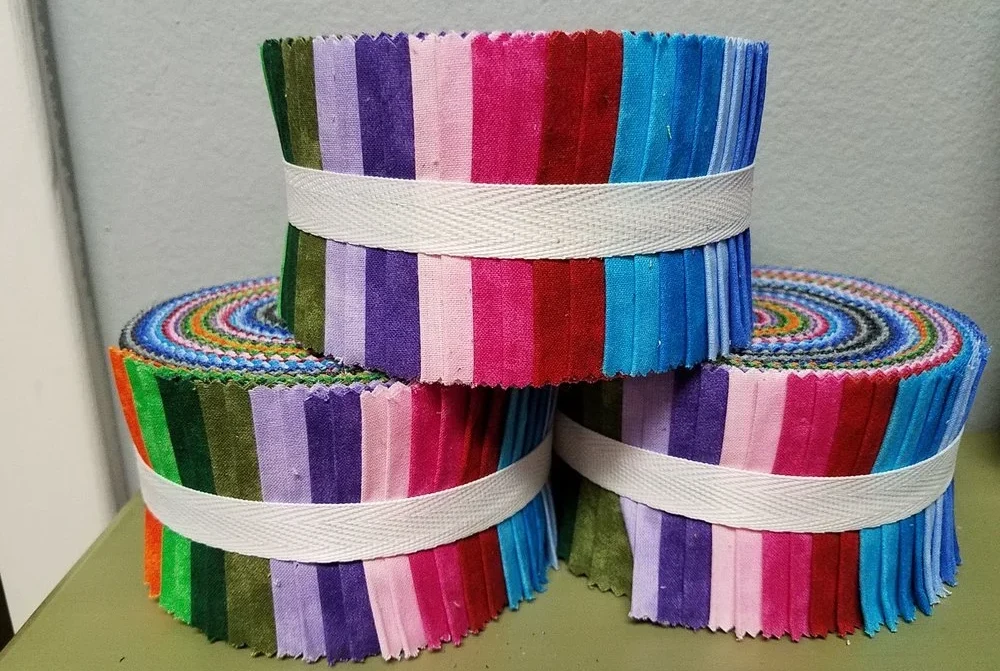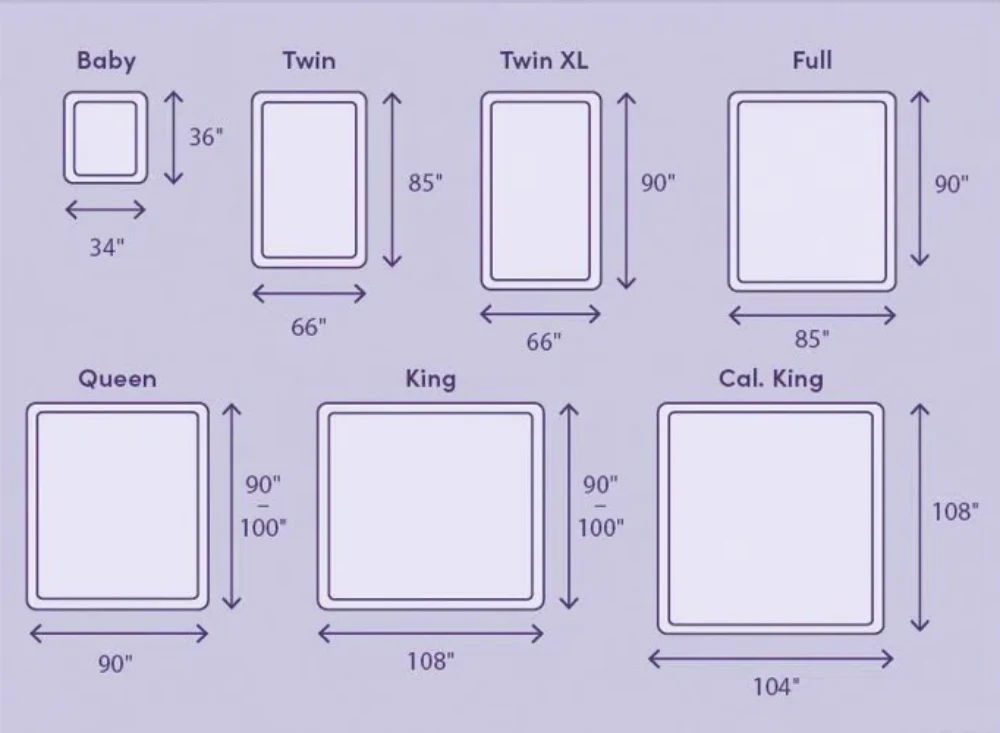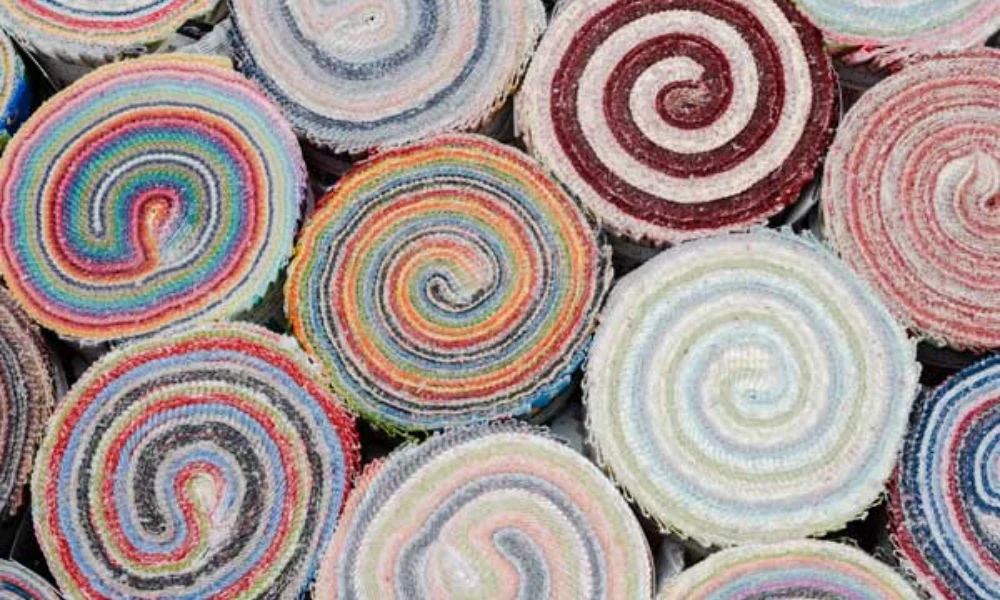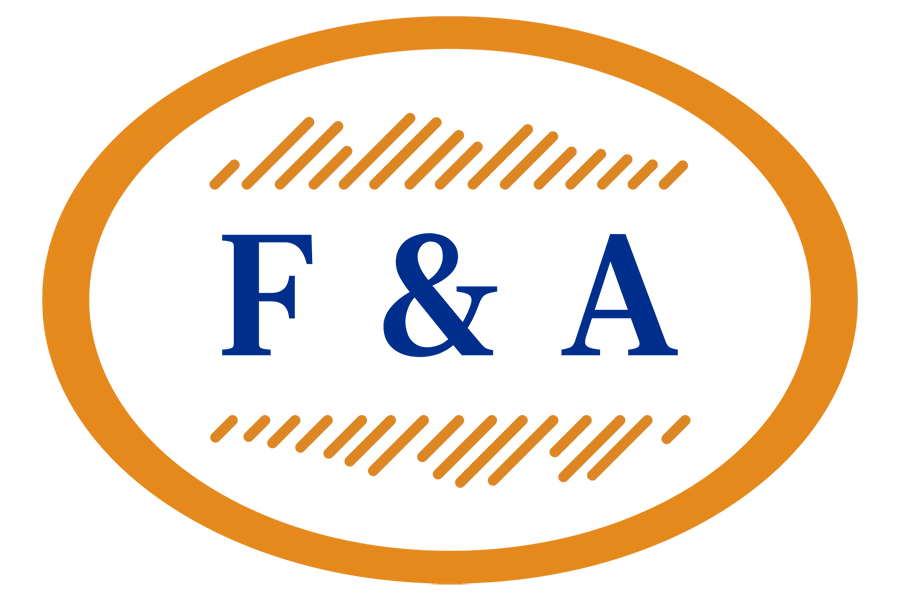You probably wonder how many jelly rolls to make a quilt for different sizes. Here’s a quick look:
Quilt Size | Number of Jelly Rolls Needed (40 strips each) |
|---|---|
Baby | 0.5–1 |
Lap | 1 |
Twin | 2 |
Queen | 3 |
King | 3 |
Fanda Fabrics gives you high-quality jelly rolls that save you time and spark creativity. Quilters love them for their convenience and vibrant patterns. This guide helps you plan your quilt project with confidence.
Key Takeaways
Determine the number of jelly rolls needed based on quilt size: 1 for baby/lap quilts, 2 for twin quilts, and 3 for queen or king quilts.
Jelly rolls contain 40 pre-cut fabric strips, each 2.5 inches wide, making them convenient for quick quilting projects.
Use a simple formula to calculate jelly rolls: measure your quilt, divide by strip width, and multiply by the number of rows.
Check your quilt pattern for specific strip requirements, as some designs may need more fabric for borders or special layouts.
Explore creative uses for leftover jelly roll strips, such as making bags, scarves, or decorative items for your home.
What Is a Jelly Roll?
Jelly Roll Definition

If you’re new to quilting, you might wonder what a jelly roll is. You’ll find that jelly rolls are bundles of pre-cut fabric strips. These strips make quilting easier and faster. You don’t need to measure or cut each piece yourself. Jelly roll strips come rolled up together, ready for you to use in your next project.
Fanda Fabrics offers jelly rolls that stand out for their quality and variety. You get soft, durable cotton in every roll. The colors and patterns are vibrant, so your quilt looks amazing. You can choose from classic prints, bold solids, or even themed designs. Jelly rolls work well for beginners and experienced quilters alike.
Tip: Jelly roll strips save you time and help you create beautiful, coordinated quilts without the hassle of cutting fabric.
Here’s what you’ll find in a standard jelly roll:
Each jelly roll contains 40 fabric strips.
Every strip measures 2.5 inches wide.
The length of each strip is usually between 42 and 44 inches.
So, if you ever ask how many strips in a jelly roll, the answer is almost always 40. These pre-cut jelly roll strips are perfect for strip quilts, borders, and quick piecing.
Standard Size and Strips
Let’s look at how Fanda Fabrics’ jelly rolls compare to other brands. You get the same trusted size and material, but with more choices in color and pattern.
Pre-cut Fabric Type | Size | Common Names | Typical Uses |
|---|---|---|---|
Jelly Rolls | 2.5″ x 42″ | Jelly Roll | Strip quilts, borders, quick piecing |
You’ll notice that the fabric strips in a jelly roll are always 2.5 inches wide and about 42 inches long. This size makes them easy to handle and sew. You can use jelly roll strips for many projects, from quilts to bags and home décor.
Fanda Fabrics gives you high-quality jelly roll strips that match industry standards. You get reliable sizing, beautiful patterns, and soft cotton every time. Whether you want a classic look or something bold, you’ll find a jelly roll that fits your style.
How Many Jelly Rolls to Make a Quilt?
Common Quilt Sizes

When you start a new jelly roll quilt, the first thing you want to know is how many jelly rolls to make a quilt for your chosen size. The answer depends on the size of your quilt. You might want a cozy baby quilt, a lap quilt for the couch, or a large bedspread. Each size needs a different number of jelly rolls.
Let’s break it down:
Baby or Lap Quilt: You only need 1 jelly roll. This is perfect for quick gifts or small projects.
Twin-Size Quilt: You will need 2 jelly rolls. This gives you enough strips for a quilt that fits a twin bed.
Queen-Size Quilt: You should plan for 3 jelly rolls. This size covers a queen bed with a nice drape.
King-Size Quilt: You also need 3 jelly rolls for a king-size quilt. The extra width and length require more strips, but three rolls will do the job.
You might wonder, “What about a throw quilt?” A throw usually falls between a baby and a lap quilt, so 1 jelly roll works well for most throw sizes.
Tip: Always check your pattern for exact measurements. Some designs use more strips, especially if you want extra borders or a special layout.
Quick Reference Table
Here’s a handy table to help you see at a glance how many jelly rolls to make a quilt for each size. This table uses Fanda Fabrics’ standard jelly roll, which has 40 strips, each 2.5 inches wide and about 42-45 inches long.
Quilt Size | Jelly Rolls Needed (40 strips each) |
|---|---|
Baby/Lap Quilt | 1 |
Throw Quilt | 1 |
Twin Quilt | 2 |
Queen Quilt | 3 |
King Quilt | 3 |
You can use this table whenever you plan a new jelly roll quilt. It makes shopping and prepping much easier.
Fanda Fabrics offers a wide variety of jelly rolls, so you can find the perfect style for any quilt size. Whether you want something classic, festive, or bold, you have plenty of options. Here’s a quick look at some of the most popular choices:
Jelly Roll Type | Description |
|---|---|
Blue Jelly Roll | Features a spectrum of azure hues, ideal for serene quilts. |
Christmas Jelly Roll | Adorned with festive colors and motifs for holiday-themed projects. |
Patriotic Jelly Roll | Includes stars and stripes in red, white, and blue for American pride. |
Red Jelly Roll | Offers a range from fiery crimson to soft blush for dramatic quilts. |
Batik Jelly Roll | Showcases intricate patterns and vibrant colors for elegant designs. |
You can mix and match these jelly rolls to create a unique jelly roll quilt every time. Fanda Fabrics makes it easy to find the right colors and patterns for your project.
Quilters often have a few questions when figuring out how many jelly rolls to make a quilt. Here are some of the most common:
How much of the 44″ fabric is generally usable when using jelly rolls?
What should you do if the strips you receive are shorter than expected?
How do you account for the trimming of selvage edges when calculating fabric length?
You should always measure your strips before you start. Most jelly rolls from Fanda Fabrics give you the full usable length, but it’s smart to double-check. If you find a strip is a little short, you can use it for piecing smaller blocks or borders.
When you trim off the selvage edges, remember to subtract that length from your total. This helps you avoid running short on fabric as you sew your jelly roll quilt.
If you want to know how many jelly rolls to make a quilt for a custom size, just count the number of strips you need for your pattern and divide by 40. This quick math helps you plan and ensures you have enough fabric for your dream quilt.
Determining Number of Strips
How Many Strips Do You Need?

When you start a new quilt, figuring out how many strips you need is one of the most important steps. You want to make sure you have enough fabric to finish your project without running short. The process for determining the number of strips is simple once you know your quilt’s size and the size of each block.
Here’s what you should do:
Measure the width and length of your finished quilt top in inches.
Decide on the width of your strips. Most jelly rolls from Fanda Fabrics are 2.5 inches wide and about 42-45 inches long.
Divide the total width of your quilt by the width of one strip to see how many strips fit across.
Multiply that number by the number of rows you want for your quilt.
Tip: Always round up to the next whole number. This helps you cover any extra seams or trimming.
If you want to make a custom quilt, you can use online tools like the Free Quilt Calculator or the Strip Calculator from Quilters Paradise. These resources make the math easy and help you plan your fabric needs.
Resource Name | Description |
|---|---|
Free Quilt Calculator | Helps you figure out how many strips and how much fabric you need for your quilt. |
Strip Calculator | Calculates yardage and strip count based on your quilt’s measurements. |
Calculation Formula
Let’s break down the formula for determining the number of strips for your quilt:
Measure your quilt’s width and length in inches.
Divide the width by 2.5 (the width of a jelly roll strip).
Multiply that result by the number of rows (length divided by 2.5).
The answer tells you how many strips you need.
For example, if your quilt is 50 inches wide and 60 inches long:
50 ÷ 2.5 = 20 strips across
60 ÷ 2.5 = 24 rows
20 x 24 = 480 strips
Since a Fanda Fabrics jelly roll has 40 strips, you would need 12 jelly rolls for a quilt this size. For most standard quilts, you need far fewer, but this shows how to size your jelly roll race quilt or any custom project.
Note: Always check your pattern for special layouts or borders. Some designs may need extra strips.
By following these steps, you can confidently answer how many strips you need for any quilt. Fanda Fabrics’ jelly rolls make the process easy, thanks to their consistent size and quality.
Factors That Affect How Many Jelly Rolls
Quilt Pattern and Design
When you plan a quilt, the pattern you choose plays a big role in how many jelly rolls you’ll need. Some quilt patterns use strips more efficiently, while others require extra fabric for complex shapes or piecing.
For example, a simple Irish Chain pattern uses fewer strips, while a Modern Workshop quilt needs more because of its intricate layout. Take a look at this table to see how different patterns affect your jelly roll usage:
Quilt Pattern | Complexity Level | Jelly Roll Strips Required |
|---|---|---|
Seasoned Pinwheels Quilt | Moderate | Varies |
Modern Workshop | High | More strips needed |
Easy Jelly Roll Irish Chain | Low | Fewer strips needed |
You can also get creative by mixing strip lengths or alternating short and long strips. This technique gives your quilt a scrappy, unique look. If you use fat quarters, try cutting them to match the length of jelly roll strips for easier planning. Here are some tips for non-standard patterns:
Recommendation | Description |
|---|---|
Piece fat quarter strips | Adjust fat quarter strips to match jelly roll strip length |
Intermingle different lengths | Mix short and long strips for a scrappier design |
Alternate short and long strips | Avoid seams lining up and add visual interest |
Fanda Fabrics offers jelly rolls in a wide range of colors and themes. You can match your pattern with the perfect color palette, making your quilt truly one-of-a-kind. The coordinated strips help you create professional results, even if you’re just starting.
Seam Allowance and Dimensions
Seam allowance might seem like a small detail, but it can change how many jelly rolls you need. If you use a scant quarter-inch seam, your blocks will stay close to the intended size. When seams are too wide, your quilt can shrink, and you may run short on strips. Always check your seam allowance before you start sewing.
The finished size of your quilt also matters. Larger quilts need more strips, while smaller ones use fewer. Here’s a quick look at common quilt sizes:
Quilt Type | Dimensions |
|---|---|
Crib Quilt | 36″ x 36″ |
Baby Quilt | 36″ x 56″ |
Lap Quilt | 48″ x 66″ |
Twin Quilt | 63″ x 87″ |
Full Quilt | 78″ x 87″ |
Queen Quilt | 84″ x 92″ |
King Quilt | 98″ x 106″ |
You’ll find that Fanda Fabrics’ jelly rolls come in packs of 24 to 40 strips, each 2.5 inches wide. This gives you plenty of options for any quilt size.
The variety of colors and themes lets you design a quilt that matches your vision, whether you want something classic or bold. The premium cotton feels soft and looks vibrant, so your finished quilt stands out.
Tip: Always double-check your pattern and measurements before you start cutting. This helps you avoid surprises and ensures you have enough jelly rolls for your project.
Make a Quilt with Fanda Fabrics Jelly Rolls
Tips for Success
You want your quilting experience to be smooth and enjoyable. Fanda Fabrics’ jelly rolls help you make a quilt with less stress and more creativity. Here are some practical tips to get the most out of your jelly rolls:
Tip | Description |
|---|---|
Save Money | Buy only what you need, so you avoid leftover yardage cluttering your space. |
Skip Hassle | Each bundle comes with coordinated colors and prints, so you skip matching fabrics yourself. |
Save Time | The strips are pre-cut and ready to use, so you can start sewing right away. |
Flexibility | Jelly rolls work for quick baby quilts or more detailed designs. |
Unique Looks | Mix and match strips for a one-of-a-kind quilt or use the bundle for a cohesive look. |
Choose Size | Pick a bundle size that fits your project and budget. |
You can store leftover strips by folding them in half, stacking neatly, and tying with ribbon. For longer strips, fold them into quarters and keep them bundled. A clear plastic bin works great for keeping jelly roll remnants organized and visible.
Fanda Fabrics stands out because you can customize your order. You choose colors, widths, and materials to match your vision. The jelly rolls use 100% cotton with a smooth weave, so your quilt feels soft and lasts for years.
The colors stay vibrant, even after many washes. You also get a huge color palette, making it easy to create a quilt that fits your style.
Tip: Always label your jelly roll remnants. This helps you keep track of colors and counts for future projects.
Creative Project Ideas
Jelly rolls aren’t just for quilts. You can use them to make a quilted scarf, oven mitt, or even a tote bag. Sew strips together to create panels for bags or baskets. Try making a pencil case to practice sewing zippers. Fabric garlands made from jelly rolls add a festive touch to your home, perfect for holidays or everyday décor.
Jelly Roll Scarf: Quick and custom gift.
Oven Mitt: Practical and fun.
Tote Bag: Stylish and sturdy.
Fabric Basket: Organize your space with color.
Pencil Case: Handy for pens or makeup.
Fabric Garland: Decorate mantles or kitchens for special occasions.
With Fanda Fabrics, you have endless ways to create a quilt or add a handmade charm to your home. You can make a quilt, design accessories, or decorate your space—all with the convenience and quality of jelly rolls.
Conclusion
You can figure out how many jelly rolls you need for any quilt by following a few simple steps:
Decide on the size of your quilt.
Calculate the area of your quilt in square inches.
Divide that number by the area one jelly roll covers (about 3200 square inches).
Round up to get the number of jelly rolls you need.
When you plan, you avoid running out of fabric or having too much left over. This makes your quilt project smoother and your final quilt looks more polished. Fanda Fabrics’ jelly rolls make it easy to start your next quilt.
Check out their website for more ideas and inspiration. With the right jelly rolls, quilting becomes fun and stress-free!
FAQ
Can you wash jelly roll strips before sewing?
You don’t need to wash jelly roll strips before sewing. The pre-cut edges can fray if you wash them. Most quilters use them straight from the roll. If you worry about shrinkage, wash your finished quilt instead.
What if you have leftover jelly roll strips?
You can use leftover strips for small projects. Try making mug rugs, scrappy borders, or fabric baskets. Store extra strips in a clear bin. Label them for easy access next time you start a project.
Can you mix jelly rolls from different brands?
Yes, you can mix jelly rolls from different brands. Just check that the strips measure 2.5 inches wide. Mixing brands lets you create unique color combinations and patterns. Always lay out your strips first to see how they look together.
How do you adjust for quilt size if you run short on strips?
Tip: Add borders or sashing to increase quilt size.
You can also combine jelly roll strips with other pre-cuts like fat quarters or charm packs. This helps you finish your quilt without buying another full jelly roll.
What quilt patterns work best with jelly rolls?
Pattern Name | Skill Level | Description |
|---|---|---|
Beginner | Fast, easy, and fun | |
Log Cabin | Intermediate | Classic block design |
Rail Fence | Beginner | Simple strip piecing |
You can try many patterns. Jelly rolls work well for strip quilts, log cabin, and rail fence designs.
